

Public Art Online Resources - Collaboration. Gallery - FlockDraw. The Sharpest Point: Animation at the End of Cinema. L'approche des médias variables. L'approche des médias variables : la permanence par le changement Permanence Through Change: The Variable Media Approach La publication L'approche des médias variables : La permanence par le changement est publiée par le Solomon R.
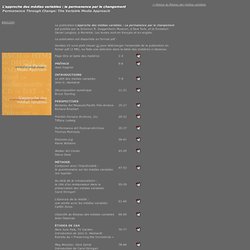
Guggenheim Museum, à New York, et la fondation Daniel Langlois, à Montréal. Les textes sont en français et en anglais. Dir.vyrd. The Average Lifespan of a Webpage. The following is a guest post by Nicholas Taylor, Information Technology Specialist for the Repository Development Group.

What is the average lifespan of webpage? Predictably, estimates vary and vary over time. A 1997 special report in Scientific American claimed 44 days. A subsequent 2001 academic study in IEEE Computer suggested 75 days. More recently, in 2003, a Washington Post article indicated that the number was 100 days. Surrealist techniques. Surrealism in art, poetry, and literature uses numerous techniques and games to provide inspiration. Many of these are said to free imagination by producing a creative process free of conscious control. The importance of the unconscious as a source of inspiration is central to the nature of surrealism. The Surrealist movement has been a fractious one since its inception. The value and role of the various techniques has been one of many subjects of disagreement. Hypertext Style: Cool URIs don't change. What makes a cool URI?
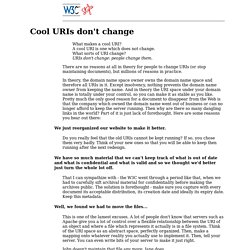
A cool URI is one which does not change. What sorts of URI change? URIs don't change: people change them. There are no reasons at all in theory for people to change URIs (or stop maintaining documents), but millions of reasons in practice. In theory, the domain name space owner owns the domain name space and therefore all URIs in it. La loi de la participation. Maîtres et élèves de la Renaissance aux Lumières. Emblématique du siècle des Lumières, comme l’attestent les oeuvres d’un Rousseau ou d’un Voltaire, la question pédagogique se voit très souvent limitée à l’étude du seul XVIIIe siècle pour l’âge classique. Pour autant, elle s’inscrit dans la continuité d’une réflexion amorcée dès la Renaissance où le rapport au savoir et, partant, la relation du maître et de l’élève, se modifient profondément. L’enseignement humaniste prend ses distances avec l’université médiévale, et notamment avec la scolastique, tout en promouvant une approche plurielle et réflexive des méthodes éducatives.
Art collaboratif. Images mises au net. Le matériel empirique sur lequel s’appuie ce texte est issu d’une enquête effectuée dans le cadre plus général d’une thèse de sociologie en partie publiée.

L’article reprend les principaux matériaux et résultats qui y sont présentés. Jean-Paul Fourmentraux, L’œuvre en actes. Travail artistique et NTIC. Sociologie du net art, thèse de doctorat en sociologie, université de Toulouse II, 2003, 422 p. J. Visual Arts - Exhibitions and Artist Portraits - Goethe-Institut. Artists in the twentieth century had a dream of full audience participation.
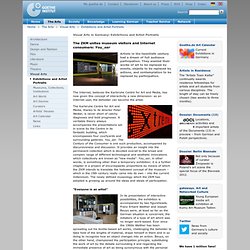
They wanted their works of art to be replaced by events, objects to be replaced by actions, and contemplation to be replaced by participation. The Internet, believes the Karlsruhe Centre for Art and Media, has now given this concept of interactivity a new dimension: as an Internet user, the beholder can become the artist. The Karlsruhe Centre for Art and Media, thanks to its director Peter Weibel, is never short of catchy diagnoses and bold prognoses. A veritable theory always accompanies the presentations set in scene by the Centre in its fantastic building, which encompasses four courtyards and surrounding galleries. 4 – Quelques exemples de recherches.
87 cool things. Design Patterns of Crowdsourced Art. Sometimes I try to google "crowdsourced art" in hopes that I'll find a comprehensive list of all such projects.
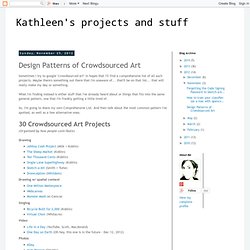
Maybe there's something out there that I'm unaware of... that'll be on that list... that will really make my day or something. What I'm finding instead is either stuff that I've already heard about or things that fits into the same general pattern, one that I'm frankly getting a little tired of. So, I'm going to share my own Comprehensive List. And then talk about the most common pattern I've spotted, as well as a few alternative ones. CrowdForge: Crowdsourcing Complex Tasks. Work marketplaces like MTurk are great for accomplishing small, well defined nuggets of work, such as labeling images and transcribing audio, but terrible for many more complex and labor intensive real world tasks.
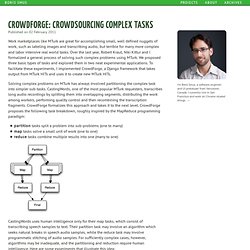
Over the last year, Robert Kraut, Niki Kittur and I formalized a general process of solving such complex problems using MTurk. We proposed three basic types of tasks and explored them in two neat experimental applications. To facilitate these experiments, I implemented CrowdForge, a Django framework that takes output from MTurk HITs and uses it to create new MTurk HITs. Solving complex problems on MTurk has always involved partitioning the complex task into simpler sub-tasks. CastingWords, one of the most popular MTurk requesters, transcribes long audio recordings by splitting them into overlapping segments, distributing the work among workers, performing quality control and then recombining the transcription fragments.
Writing Articles. Reseau social. Collaborative Arts. Brainch. Presentation graphic design studio in Brussels: studied at PZI, Rotterdam and graphic design in Valenceworks both on print and digital media. special interest in scriptinginterest for libre philosophyin softwarebut also in other cultural and social production fieldsinterests for tools for sharing and producing knowledgepart of Open Source Publishing, designing only with libre tools Introduction Brainch is a software for collective writing of personal/critical texts.

It allows its practitioners to duplicate and modify their peers' texts. Several versions of a text can exist in parallel and can later be merged or not according to the convergences or divergences of the authors' opinions. Origins of the project. Chinese whispers. Chinese whispers[1] (or telephone in the United States[2]) is a game played around the world, in which one person whispers a message to another, which is passed through a line of people until the last player announces the message to the entire group.
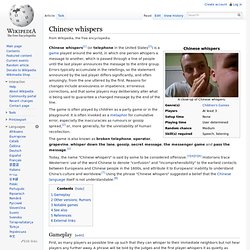
Errors typically accumulate in the retellings, so the statement announced by the last player differs significantly, and often amusingly, from the one uttered by the first. Reasons for changes include anxiousness or impatience, erroneous corrections, and that some players may deliberately alter what is being said to guarantee a changed message by the end of the line. The game is often played by children as a party game or in the playground. It is often invoked as a metaphor for cumulative error, especially the inaccuracies as rumours or gossip spread,[2] or, more generally, for the unreliability of human recollection.
Où Breton puisa son inspiration. Xavier de la Porte. Qu'est-ce que le virtuel? Pierre Lévy Table des matières.
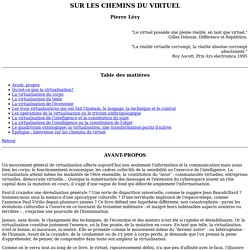
Creative Commons : vidéo d’animation explicative.
MIT Media Lab. Sigir.dvi - mission4636.pdf. Persée : Portail de revues en sciences humaines et sociales. Web Net Museum-Fred forest-Retrospective-Art sociologique-Esthetique de la communication-Textes critiques-Manifeste pour une esthetique de la communication, par Fred Forest. Manifeste pour une esthétique de la communication par Fred Forest 1983 1- Esthétique de la communication et intervention sur la réalité comme activité symbolique et esthétique L'Esthétique de la Communication conçoit de transposer directement les principes sensibles observés dans l'évolution de notre environnement et du monde sur le fonctionnement de l'art lui-même et de considérer désormais celui-ci non plus en termes d'objets isolés, mais en termes de relations et d'intégration.
Les oeuvres, les données, les systèmes d'art devront être appréhendés comme des touts intégrés. Cours: sommaire.
Tim Brown sur la créativité et le jeu. Experiments. Suler.pdf. Ga2003_what_is_genart.pdf. Web 2.0 = Pédagogie 2.0 ? Cours et synthèse collective (université de Laval, Québec)